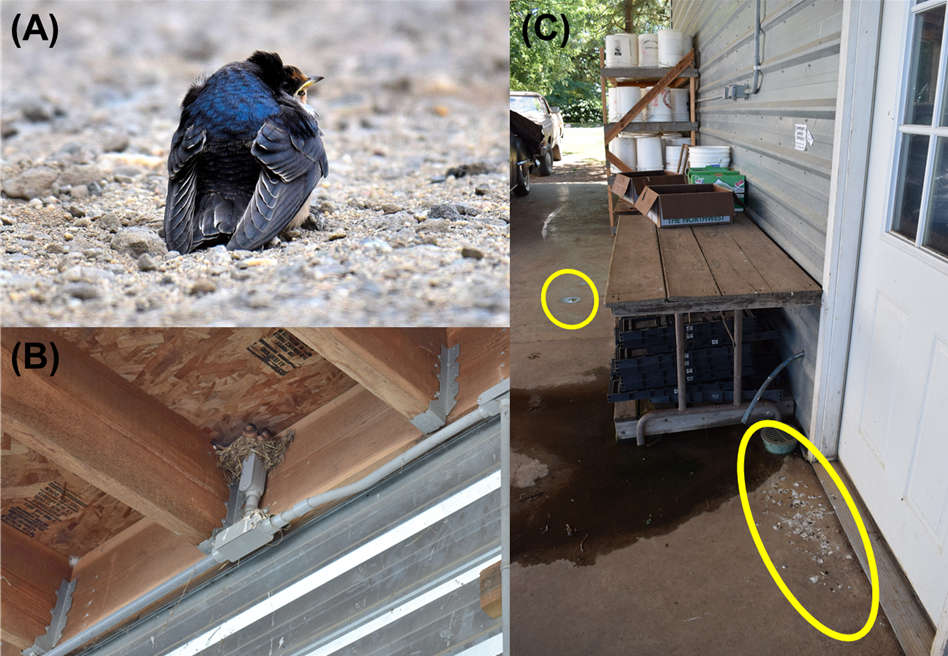Promoting birds in agroecosystems is contentious. In their latest research, Olivia Smith and colleagues demonstrate how farmers can use landscape and farm diversification practices to harness ecosystem services from birds while reducing negative trade offs.
Birds play many roles in human societies, including as consumers of crops and pests, carriers of pathogens and beloved icons.
Consider, for example, the nearly globally distributed barn swallow. The barn swallow is a source of endless fascination for those who pause to watch them – drawn to look up by their complex, mechanical sounding whirrs and chirps, observers will be rewarded with a display of agile twists, turns, loops, and swirls.
These aerial acrobatics occur while they are foraging for arthropods, including agricultural pests. Accordingly, many farmers believe that barn swallows can be an important part of an integrated pest management system. However, they are often deterred from nesting on farm structures because they can carry human foodborne pathogens and defecate where produce is being processed. Indeed, it is this complex interplay of costs and benefits associated with birds in agricultural systems which formed the basis for our study.

We conducted a four year project along the West Coast of the United States where, living in a van during the summer months, I drove farm-to-farm carrying out bird surveys on conservation-minded (mostly organic) farms.
I used my bird survey data to identify the bird species present at each farm and estimated the number of individuals per species. I then created estimates of costs and benefits provided by birds to farmers and society as a whole by weighting the bird survey data by bird diet guild, estimated propensity to contaminate crops with foodborne pathogens, national iconic value, grower appreciation and disapproval from questionnaire survey data, and conservation concern. Finally, I looked at how these estimated costs and benefits correlated with each other and with management at different spatial scales.

For management aspects, I examined how vertically complex the local vegetation was (e.g., tall hedges next to fields vs. low-growing crops), how conservation-friendly the farms were overall, and how much semi-natural cover there was in a larger (2100 m) radius around the survey location.
Crucially, we were interested in the average costs and benefits provided by the birds as well as how much the costs and benefits fluctuated over time. The issue of stability is important from a farmer’s perspective generally, but becomes especially pertinent for the small-scale farmers I worked with because they rely on birds for biological control.
Our results showed that the indices quantifying the beneficial aspects of birds (crop production benefits via pest control, grower appreciation, and conservation scores) were positively correlated with each other. The indices quantifying the harmful aspects of birds (foodborne pathogen risk and grower disapproval) were also strongly positively correlated with each other – but not strongly correlated to most of the beneficial aspect indices.
Farms that implemented more farm-wide conservation-friendly management practices generally had higher average indices quantifying the benefits of birds, but farm management did not impact indices quantifying the harmful aspects, except for the metric representing birds the farmers disliked. Average indices estimating the harmful aspects of birds were lower on farms in landscapes with more semi-natural cover.

Higher local vertical vegetation complexity (e.g., crops next to full hedges) tended to increase the temporal stability of indices estimating the beneficial aspects of birds but did not affect the indices estimating the harmful aspects. Greater amounts of semi-natural cover in the landscape was generally associated with increased temporal stability of indices quantifying both the beneficial and harmful aspects of birds. That is, greater amounts of semi-natural cover in the broader landscape not only led to generally lower harm scores but stably lower harm scores.
Altogether, our results suggest that farmers can effectively manage their farms to garner the benefits from birds through whole-farm conservation-friendly practices. However, the harms associated with birds seem to be mitigated most effectively by having more semi-natural cover in the broader landscape, which may also stabilize both the benefits and harms provided by birds.
Importantly, current preservation of seminatural cover in agricultural systems is low. Thus, greater incentives for farmers to increase semi-natural cover at the landscape-scale are needed to achieve multifunctional outcomes for conservation and agriculture.
Read the full paper Complex landscapes stabilize farm bird communities and their expected ecosystem services in Journal of Applied Ecology.
